
Tibet only recently opened after being closed to tourists due to the one-year anniversary of the unrest that occurred there last spring. When the ban was lifted, in typical fashion, China issued a press release saying that visitors had never been barred from entering the area in the first place! Things are pretty locked down right now and the only way to gain entry is to go on an organized tour. I booked the standard 8-day overland tour from Kathmandu, and was able to extend my stay for a few days afterwards in Lhasa. The trip had a great mix of people, most of whom were backpackers who would never of their own free will go on an organized tour.
We started early in the morning from Kathmandu and reached the border after about 4 hours driving along a windy mountain road. It took about a half hour to get through the Nepal side, and another 3 hours on the Chinese side. The swine flu scare had just hit and there was a hastily set up health checkpoint where we all had to get our temperature taken (and answer some questions about our health: were we "snivelling"? How about "psychotic"?). I was surprised by how disorganized it all was - I was expecting some kind of severe efficiency.
In a strange, welcome-to-Tibet moment, while it had been sunny when we went into the border crossing building, we came out into torrential rain. Our tour guide hurriedly divided us 4-at-a-time into Land Cruisers, which are the standard form of transportation in this area of the world. Evidently the roads used to be really bad around there but other than the first half day they turned out to be nice and new. China is investing a lot in infrastructure, at least on the route from Nepal. After some road construction delays, we pulled into a basic hotel in a truck stop of a town late at night.

The next morning, after a breakfast of omelettes and Tibetan bread, we set out. The goal for that day was to make it to the small town of Lhatse. We climbed for a couple of hours through the mountains, crossed the very high (5,400m) Lalung-La pass, and found ourselves on the Tibetan Plateau. The scenery was unbelievable - flat barren plains for miles around, and mountains in all directions in the distance. The sky was enormous.
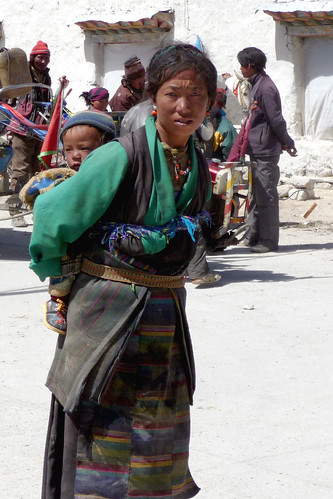
We stopped for lunch in a small village, and had our first real encounters with Tibetan culture. The people were extremely friendly, though shy and not terribly fond of having their picture taken. The women wore colorful patterned skirts and generally frumpy sweaters and jackets. The men dressed ruggedly in dark greys and purples, and had a bit of a cowboy look with wide-brimmed hats and boots. Horses and ox-drawn carts were common, as were enormous tractor-pulled flat beds.
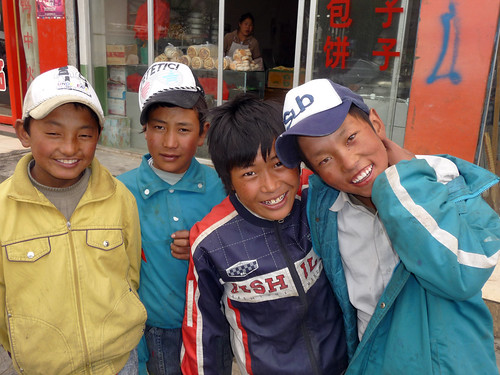
At lunchtime, we made the decision to continue on past Lhatse to spend the night in Shigatse, which was originally supposed to be our stop for the third night. This was great news, as I'd heard reports about how gross the hotel in Lhatse was supposed to be. Along the way, the Himalayas were in the distance, and were even able to see Mt. Everest (looked pretty small from there). After a brief stop in Lhatse to check it out, we continued on. It was in Lhatse where I noticed the strange effect my height had on people up there. The difference between my height and the average Tibetan´s was even greater than in India and Nepal. I attracted a giggling crowd of kids who couldn't stop pointing at me. This would become a bit ridiculous by the time I got to Lhasa! Nearly everyone would look at me, smile and chuckle, and often comment to me about how big I was. It was a good ice breaker if nothing else.
The rest of the day was a long drive through the plateau. We went through another mountain pass, and passed some nicely done-up yaks who were plowing a field. Our hotel in Shigatse was pretty plush - double rooms with a Western style bathroom complete with a bathtub. After dinner in a nearby restaurant, I called it a night, though evidently some others on the tour found a crazy karaoke nightclub. Shigatse was the first place where you could really see the extent of Chinese influence in Tibet. Tibet's second-largest city, it boasts a large, modern Chinese section of town, as well as a Tibetan old town. This pattern was repeated in the other cities we visited as well. The wealth on display in the Chinese area (huge stores full of motorbikes, appliances, etc) was in stark contrast to the modest means of most Tibetans we ran into. Many of the Tibetans had a weathered look about them, as if they had been through a lot of hardship, though almost universally the Tibetans had a cheerful attitude about them.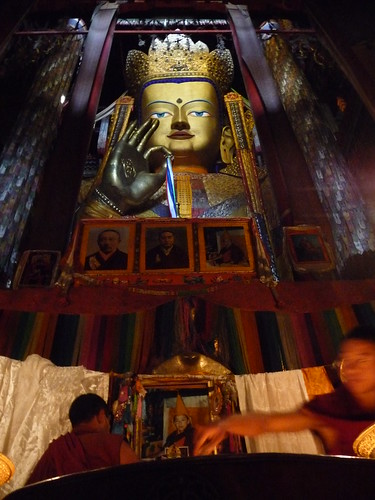
The next morning we visited the amazing Tashi Lhunpo Monastery, traditional home of the Panchen Lama. Monasteries in Tibet are bittersweet experiences, as many of them had been partially or completely destroyed by the Chinese during the excesses of the Cultural Revolution in the 1960s. Some had even been shelled by the Red Army, either during the initial takeover of Tibet in 1959 or later. In an ironic turn of events, Tibet has developed into a significant tourist draw for Chinese, and the reconstruction of the monasteries has been receiving quite a bit of funding. Many of the temples in the monasteries we visited were re-creations of the originals, including rebuilt Buddha statues and wall paintings. The main temple at Tashilhumpo, fortunately, had escaped destruction and we were able to view it as living and intact. Large bowls containing yak butter lamps illuminated an enormous Buddha overhead, as monks seated in one corner continuously chanted Buddhist prayers aloud.
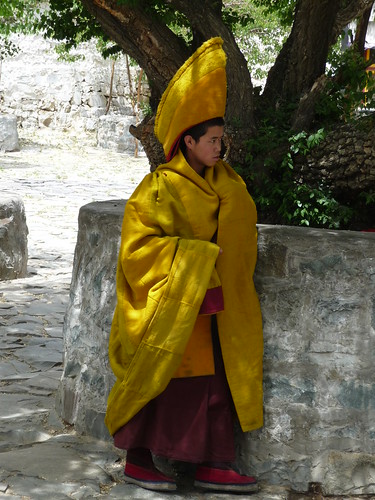
We wandered through this and other temples at the monastery, before stumbling upon a courtyard where young monks were practicing their knowledge of Buddhist scriptures by debating. Some of the arguments would get pretty lively, and be emphasized by loud claps of hands followed by a pointed hand gesture as one of the monks asked or answered a key question. Towards the end of the debate session, monks appeared dressed in the yellow robes and large plumed hats of the Gelugpa Buddhist sect. Afterwards, we were lucky to be allowed to sit in the back of a gathering hall as the monks had their lunchtime meal of tsampa (barley flour dough with yak butter tea) and prayers. One monk was designated as the entertainment for the session, and would pace back and forth making jokes and comments, punctuated by more claps and pointing. We had a strong suspicion that many of the jokes (in Tibetan) were directed towards us, but still felt very priviledged to be able to watch this.
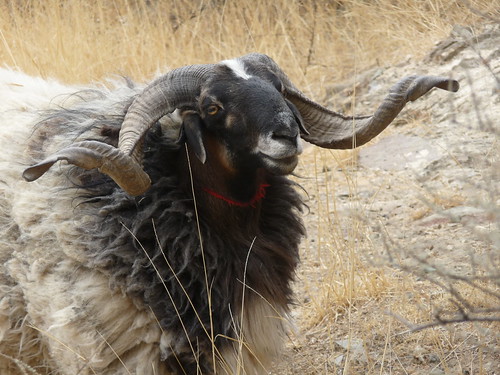
In the afternoon, the tour group split up, and I ended up having a great time checking out the area with Brit Pete Barlett. We completed the kora, or holy walking path, around the monastery and up into the hills, accompanied by an endless stream of local Tibetans. Also checked out the Tibetan old town, with its many white-washed houses and ornate wood-carved windows.
That night I had dinner with Raffaela from Italy, who was determined to try as many local specialities as possible - nearly all of which involved yak. It's hard to overstate how much yak is eaten up in Tibet. Luckily it's not that bad. Fairly close to beef unless you get some of the tougher parts. Raffaela ordered yak lung, and I ordered the rather pedestrian grilled yak. The waiter placed a dish in front of me, so I assumed it was my meal. After eating about a third of it, my grilled yak meal actually arrived and we realized I'd been tucking in to a big plate of lung! Kind of fatty, but otherwise pretty good.
On the grand scale of all things yak, yak cheeseburgers were the big winner, followed by yak steak, yak sizzler, and yak curry. At the other end of the spectrum would be yak butter tea, which is a staple drank often by most Tibetans. Salty, fatty and hard to describe, it doesn't taste at all like tea. The closest I can come is that it's like drinking a potato chip. I learned that if you finished a cup to be polite, Tibetan hospitality would ensure that your cup was quickly refilled again. So I had to avoid my natural tendency to clean my plate and empty my cup in order to avoid yak butter tea overload.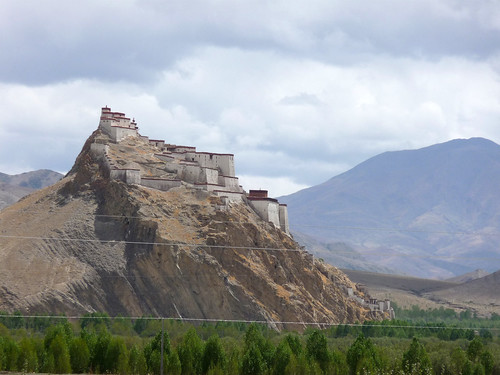
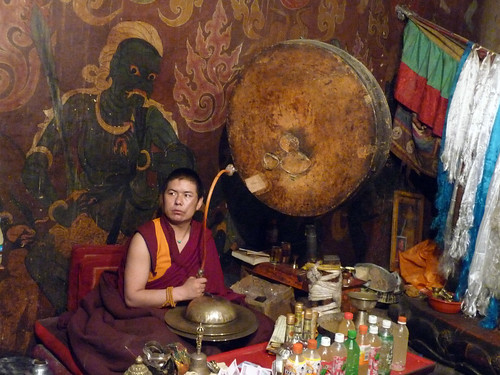
The next day we were off to the town of Gyanze, home of the Palcho Monastery. It seemed much less lively than the Tashi Lunpo Monastery, though I did get into a fight with a monk who wanted to make me pay twice to photograph inside the temple. Highlights were a cool, creepy room devoted to some of the darker Tantric deities, and the enormous Khumbum stupa. This is the largest stupa in Tibet - a nine story structure with over 70 different rooms full of paintings and sculptures of deities. It was pretty mind-boggling and beautiful. On top was a huge pair of Buddha eyes looking out on the nearby fortress.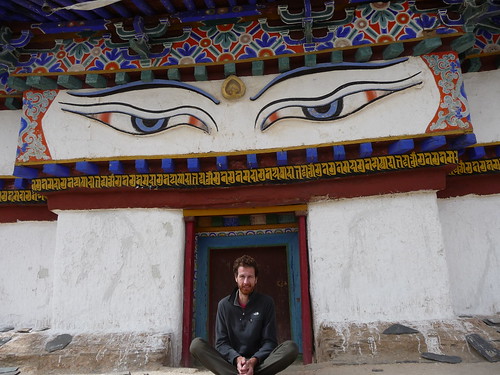
Monday, June 8, 2009
On the road to Lhasa
Subscribe to:
Post Comments (Atom)
1 comments:
Can't wait till you get to the Egham leg of your journey. That will be REALLY exotic!
Post a Comment